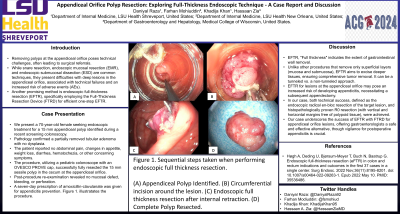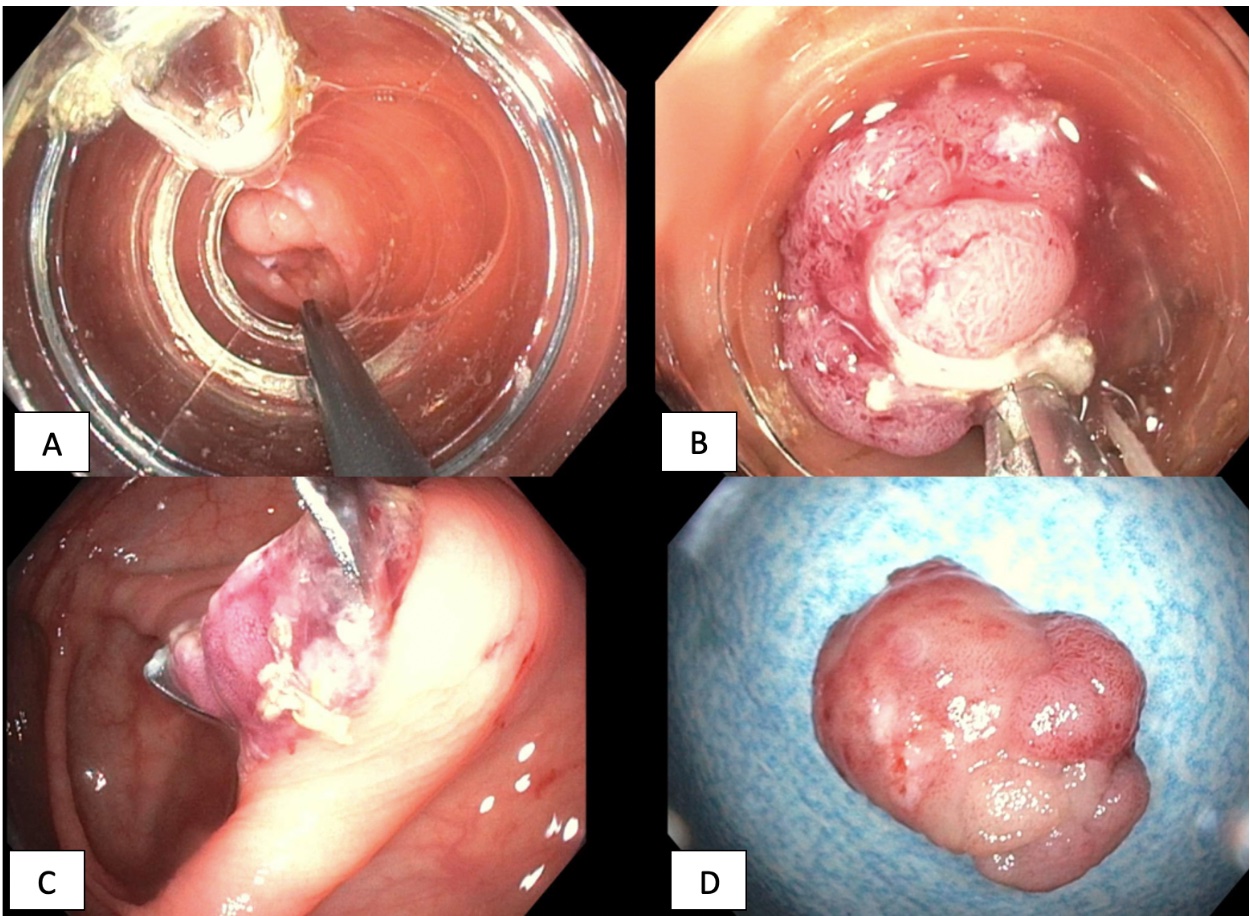Sunday Poster Session
Category: Interventional Endoscopy
P1103 - Appendiceal Orifice Polyp Resection: Exploring Full-Thickness Endoscopic Technique - A Case Report and Discussion
Sunday, October 27, 2024
3:30 PM - 7:00 PM ET
Location: Exhibit Hall E

Has Audio

Daniyal Raza, MD
LSU Health
Shreveport, LA
Presenting Author(s)
Award: Presidential Poster Award
Daniyal Raza, MD1, Farhan Mohiuddin, MD2, Khadija Khan, MD1, Hassaan A. Zia, MD1
1LSU Health, Shreveport, LA; 2LSU Health, New Orleans, LA
Introduction: Removing polyps at the appendiceal orifice poses technical challenges, often leading to surgical referrals. While snare resection, endoscopic mucosal resection (EMR), and endoscopic submucosal dissection (ESD) are common techniques, they present difficulties with deep lesions in the appendiceal orifice, associated with technical failures and an increased risk of adverse events (AEs) (1-3). Another promising method is endoscopic full-thickness resection (EFTR) (4), specifically employing the Full-Thickness Resection Device (FTRD) for efficient one-step EFTR.
Case Description/Methods: We present a 70-year-old female seeking endoscopic treatment for a 15 mm appendiceal polyp identified during a recent screening colonoscopy. Pathology confirmed a partially removed tubular adenoma with no dysplasia. The patient reported no abdominal pain, changes in appetite, weight loss, diarrhea, hematochezia, or other concerning symptoms. The procedure, utilizing a pediatric colonoscope with an OVESCO PROVE cap, successfully resected the 15 mm sessile polyp in the cecum at the appendiceal orifice. Post-procedure re-examination revealed no mucosal defect, bleeding, or perforation. A seven-day prescription of amoxicillin-clavulanate was given for appendicitis prevention. Figure 1 illustrates the procedure.
Discussion: In EFTR, "Full thickness" indicates the extent of gastrointestinal wall removal. Unlike other procedures that remove only superficial layers (mucosa and submucosa), EFTR aims to excise deeper tissues, ensuring comprehensive tumor removal. It can be a tunneled vs. a non-tunneled approach. EFTR for lesions at the appendiceal orifice may pose an increased risk of developing appendicitis, necessitating a subsequent appendectomy. In our case, both technical success, defined as the endoscopic radical en-bloc resection of the target lesion, and histopathologically proven R0 resection (with vertical and horizontal margins free of polypoid tissue), were achieved. Our case underscores the success of EFTR with FTRD for appendiceal orifice lesions, offering gastroenterologists a safe and effective alternative, though vigilance for postoperative appendicitis is crucial.

Disclosures:
Daniyal Raza, MD1, Farhan Mohiuddin, MD2, Khadija Khan, MD1, Hassaan A. Zia, MD1. P1103 - Appendiceal Orifice Polyp Resection: Exploring Full-Thickness Endoscopic Technique - A Case Report and Discussion, ACG 2024 Annual Scientific Meeting Abstracts. Philadelphia, PA: American College of Gastroenterology.
Daniyal Raza, MD1, Farhan Mohiuddin, MD2, Khadija Khan, MD1, Hassaan A. Zia, MD1
1LSU Health, Shreveport, LA; 2LSU Health, New Orleans, LA
Introduction: Removing polyps at the appendiceal orifice poses technical challenges, often leading to surgical referrals. While snare resection, endoscopic mucosal resection (EMR), and endoscopic submucosal dissection (ESD) are common techniques, they present difficulties with deep lesions in the appendiceal orifice, associated with technical failures and an increased risk of adverse events (AEs) (1-3). Another promising method is endoscopic full-thickness resection (EFTR) (4), specifically employing the Full-Thickness Resection Device (FTRD) for efficient one-step EFTR.
Case Description/Methods: We present a 70-year-old female seeking endoscopic treatment for a 15 mm appendiceal polyp identified during a recent screening colonoscopy. Pathology confirmed a partially removed tubular adenoma with no dysplasia. The patient reported no abdominal pain, changes in appetite, weight loss, diarrhea, hematochezia, or other concerning symptoms. The procedure, utilizing a pediatric colonoscope with an OVESCO PROVE cap, successfully resected the 15 mm sessile polyp in the cecum at the appendiceal orifice. Post-procedure re-examination revealed no mucosal defect, bleeding, or perforation. A seven-day prescription of amoxicillin-clavulanate was given for appendicitis prevention. Figure 1 illustrates the procedure.
Discussion: In EFTR, "Full thickness" indicates the extent of gastrointestinal wall removal. Unlike other procedures that remove only superficial layers (mucosa and submucosa), EFTR aims to excise deeper tissues, ensuring comprehensive tumor removal. It can be a tunneled vs. a non-tunneled approach. EFTR for lesions at the appendiceal orifice may pose an increased risk of developing appendicitis, necessitating a subsequent appendectomy. In our case, both technical success, defined as the endoscopic radical en-bloc resection of the target lesion, and histopathologically proven R0 resection (with vertical and horizontal margins free of polypoid tissue), were achieved. Our case underscores the success of EFTR with FTRD for appendiceal orifice lesions, offering gastroenterologists a safe and effective alternative, though vigilance for postoperative appendicitis is crucial.

Figure: Figure 1. Sequential steps taken when performing endoscopic full thickness resection. (A) Appendiceal Polyp Identified. (B) Circumferential incision around the lesion. (C) Endoscopic full thickness resection after internal retraction. (D) Complete Polyp Resected.
Disclosures:
Daniyal Raza indicated no relevant financial relationships.
Farhan Mohiuddin indicated no relevant financial relationships.
Khadija Khan indicated no relevant financial relationships.
Hassaan A. Zia indicated no relevant financial relationships.
Daniyal Raza, MD1, Farhan Mohiuddin, MD2, Khadija Khan, MD1, Hassaan A. Zia, MD1. P1103 - Appendiceal Orifice Polyp Resection: Exploring Full-Thickness Endoscopic Technique - A Case Report and Discussion, ACG 2024 Annual Scientific Meeting Abstracts. Philadelphia, PA: American College of Gastroenterology.


